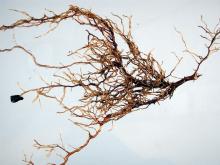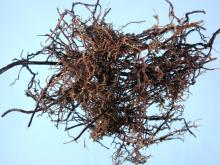Cause There are several different root rot causing organisms occur on Viburnum with Phytophthora spp. and Rhizoctonia sp. being found most often. These soil-borne pathogens initially infect small feeder roots, and then spread to the main roots. Plant crowns may be invaded if conditions remain conducive for spread.
Surveys of nurseries in the Midwest have found P. cactorum, P. citicola and P. hedraiandra from viburnum. Poorly drained, waterlogged soil or media, plastic ground covers, or media favors these water-mold organisms. They survive unfavorable periods as oospores or chlamydospores in plant debris. These spores can persist several years. Long-distance movement of infected plants and/or soil can spread the microorganism, as well as contaminated plant debris, potting media, or water. Spores germinate and produce sporangia and a swimming spore stage called zoospores. Inoculum build up is greatest under saturated conditions. These spores are attracted to the fine roots where they attack and begin to rot the root system. After infection, the microorganism spreads, mainly in the inner bark tissues of the root and stems.
Rhizoctonia survives in the soil as sclerotia or as mycelium colonizing bits of organic matter. Roots become infected as they grow past these structures. The fungus then grows along root surface, forms an aggregation called an infection cushion, pushes into the root where it colonies, and spreads and kills the tissue. The fungus can form knots of mycelium that develop into sclerotia. These are released into the soil as the plant debris decomposes.
Symptoms Above-ground symptoms of root rot include yellowing of leaves, sudden wilting, premature leaf drop, slowed shoot growth, branch dieback, and plant death. P. hedraiandra from viburnum also produced stem lesions, crown and root rot.
Rhizoctonia infected roots, crowns, and stems turned dark brown, leaves gradually became necrotic, and infected plants were often killed.
Cultural control Use many different tactics to manage root rots but focus efforts on water management.
- Quarantine new plants at least 1 year before setting them out in the production area. Examine and destroy any plants that show disease.
- Use pathogen-free cuttings.
- Provide good drainage for plants in beds, fields, or containers. Place containers on gravel beds (4 inches or more deep) to allow drainage. Do not place containers on poly sheets; they can prevent containers from draining into soil and allow contaminated drainage water to spread from the base of one container to another.
- Rapid drainage of container media throughout the production cycle of the crop is critical.
- Use raised beds in landscape plantings.
- Use care in watering. If using a hose, take care not to splash, and keep the nozzle and hose off the ground, walkways, or other surfaces that may be contaminated.
- Keep benches and premises clean. Do not use sides of low benches as a footrest; soil on shoes may be contaminated. Keep walkways and areas beneath benches clean and free of plant debris.
- Clean all propagating tools with disinfectants.
- Use clean irrigation water.
- Avoid reusing pots from a previous crop for propagation. If pots must be reused then wash off all debris and soak in a sanitizing solution or treat with aerated steam for 30 min.
Chemical control Chemical treatment should be preceded by an accurate diagnosis since most of the chemicals are not effective against all pathogens that might cause damping-off.
For Rhizoctonia:
- Broadform at 2 to 8 fl oz/100 gal water. Group 7 + 11 fungicide. 12-hr reentry.
- Empress at 2 to 6 fl oz/100 gal water. Group 11 fungicide. 12-hr reentry.
- Mural at 2 to 3 oz/100 gal water used as a drench. Group 7 + 11 fungicide. 12-hr reentry.
- Pageant at 12 to 18 oz/100 gal water. Do not use with organosilicone-based adjuvants. Group 7 + 11 fungicide. 12-hr reentry.
For Phytophthora: Many different fungicides are labeled for this disease but do not have viburnum on the label but may legally be used. Test first on a small section before applying on the whole plant to evaluate possible phytotoxicity.
- Phospho-Jet is registered as a basal bark spray at 62.4 fl oz in 62.4 fl oz water plus 3 fl oz of Pentra-Bark. Group P7 fungicide. 4-hr reentry.
Biological control Use in conjunction with other control tactics such as thorough sanitation.
- RootShield Plus Granules (Trichoderma harzianum Rifai strain T-22 and T. virens strain G-41) at 1 to 3 lb/ cubic yard soil mix. No restrictions on reentry required when soil incorporated. O
- Bio-Tam 2.0, Tenet WP, or Obtego (Trichoderma asperellum and T. gamsii) at 0.5 to 1.5 lb/cubic yard of substrate. See label for details and other application methods. No restrictions on reentry when soil incorporated. O
- SoilGard (Gliocladium virens strain GL-21) at 2 to 4 oz/100 gal water. Group BM02 fungicide. 4-hr reentry. O
References Baysal-Gurel, F., and Kabir, N. 2018. Comparative performance of fungicides and biocontrol products in suppression of rhizoctonia root rot in viburnum. J Plant Pathol Microbiol DOI:10.4172/2157-7471.1000451
Klingeman, W.E., White, S.A., LeBude, A., Fulcher, A., Gauthier, N.W., and Hale, F. 2014. Arthropod pests, plant diseases and abiotic disorders and their management on Viburnum Species in the Southeastern US: A Review. Journal of Environmental Horticulture 32:84-102.
Schwingle, B.W., Smith, J.A., and Blanchette, R.A. 2007. Phytophthora species associated with diseased woody ornamentals in Minnesota nurseries. Plant Disease 91:97-102.



